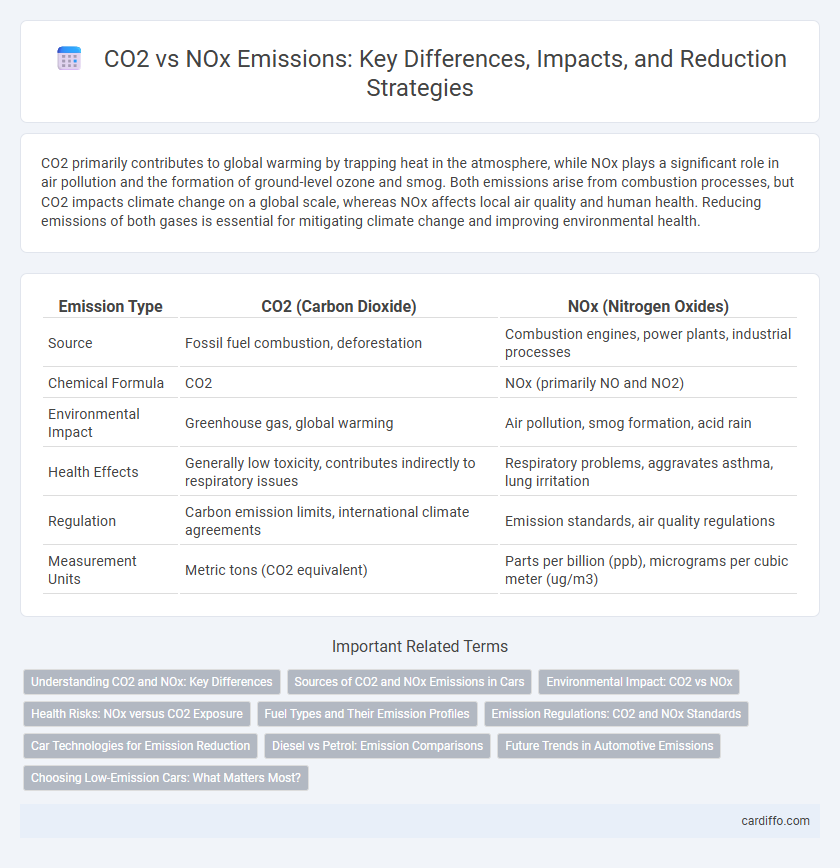CO2 primarily contributes to global warming by trapping heat in the atmosphere, while NOx plays a significant role in air pollution and the formation of ground-level ozone and smog. Both emissions arise from combustion processes, but CO2 impacts climate change on a global scale, whereas NOx affects local air quality and human health. Reducing emissions of both gases is essential for mitigating climate change and improving environmental health.
Table of Comparison
| Emission Type | CO2 (Carbon Dioxide) | NOx (Nitrogen Oxides) |
|---|---|---|
| Source | Fossil fuel combustion, deforestation | Combustion engines, power plants, industrial processes |
| Chemical Formula | CO2 | NOx (primarily NO and NO2) |
| Environmental Impact | Greenhouse gas, global warming | Air pollution, smog formation, acid rain |
| Health Effects | Generally low toxicity, contributes indirectly to respiratory issues | Respiratory problems, aggravates asthma, lung irritation |
| Regulation | Carbon emission limits, international climate agreements | Emission standards, air quality regulations |
| Measurement Units | Metric tons (CO2 equivalent) | Parts per billion (ppb), micrograms per cubic meter (ug/m3) |
Understanding CO2 and NOx: Key Differences
CO2, or carbon dioxide, is a greenhouse gas primarily released from burning fossil fuels, contributing significantly to global warming by trapping heat in the atmosphere. NOx, or nitrogen oxides, are nitrogen-based pollutants produced mainly during combustion processes, causing harmful effects on air quality, human health, and acid rain formation. Unlike CO2, which has a long atmospheric lifetime and affects climate change globally, NOx impacts are more localized but contribute indirectly to ozone layer depletion and secondary particulate matter.
Sources of CO2 and NOx Emissions in Cars
CO2 emissions in cars primarily originate from the combustion of fossil fuels such as gasoline and diesel during engine operation. NOx emissions result mainly from high-temperature reactions between nitrogen and oxygen in the engine cylinder, especially in internal combustion engines under lean burn conditions. Tailpipe emissions reflect these processes, with CO2 linked to carbon content in fuel and NOx influenced by combustion temperature and oxygen availability.
Environmental Impact: CO2 vs NOx
CO2 primarily contributes to global warming by enhancing the greenhouse effect, leading to long-term climate change and rising sea levels. NOx emissions cause immediate environmental harm by forming ground-level ozone and particulate matter, which degrade air quality and harm human health. While CO2 accumulates in the atmosphere, influencing global temperature trends, NOx triggers localized smog and acid rain, impacting ecosystems and biodiversity.
Health Risks: NOx versus CO2 Exposure
NOx emissions pose significant health risks due to their role in respiratory problems, including asthma, bronchitis, and decreased lung function, while CO2 primarily contributes to climate change rather than direct toxicity. Exposure to high levels of NOx can lead to inflammation of the airways and increased susceptibility to respiratory infections. Unlike CO2, which is relatively harmless at environmental concentrations, NOx compounds are potent irritants with immediate and severe impacts on human health.
Fuel Types and Their Emission Profiles
Diesel engines produce higher NOx emissions compared to gasoline engines due to combustion characteristics, while gasoline engines emit more CO2 per liter of fuel burned. Natural gas vehicles offer lower CO2 and NOx emissions, benefiting from cleaner combustion of methane. Biofuels, such as ethanol and biodiesel, reduce net CO2 emissions through carbon capture during feedstock growth but may vary in NOx output depending on the engine and blend used.
Emission Regulations: CO2 and NOx Standards
Emission regulations for CO2 primarily target greenhouse gas reduction to combat climate change, with global standards pushing for lower carbon dioxide limits in vehicles and industries. NOx standards concentrate on reducing harmful nitrogen oxides that cause air pollution and health problems, often enforced through stringent limits in urban and industrial areas. Regulatory frameworks such as the European Union's Euro standards and the United States Environmental Protection Agency (EPA) rules impose specific emission caps to ensure compliance and promote cleaner technologies.
Car Technologies for Emission Reduction
Advanced car technologies deploy selective catalytic reduction (SCR) and exhaust gas recirculation (EGR) systems to efficiently reduce NOx emissions while balancing CO2 output. Hybrid and electric vehicles significantly cut CO2 by minimizing or eliminating combustion, contrasting with diesel engines that achieve lower CO2 but face challenges in NOx control. Optimizing engine calibration and employing particulate filters alongside these innovations enhances overall emission reduction, aligning with stringent environmental regulations.
Diesel vs Petrol: Emission Comparisons
Diesel engines emit significantly higher levels of nitrogen oxides (NOx) compared to petrol engines, impacting air quality and contributing to smog formation. Petrol engines generally produce more carbon dioxide (CO2) per liter of fuel burned due to lower fuel efficiency than diesel counterparts. Regulatory standards targeting these emissions drive advances in catalytic converters and particulate filters to reduce both NOx and CO2 pollution from internal combustion engines.
Future Trends in Automotive Emissions
Future trends in automotive emissions are increasingly centered on reducing CO2 and NOx pollutants through innovative technologies. Electrification and hydrogen fuel cells promise drastic CO2 reductions, while advanced combustion techniques and selective catalytic reduction systems target NOx emission control. Regulatory pressures and sustainability goals are driving automakers to adopt zero-emission vehicles and stricter emission standards globally.
Choosing Low-Emission Cars: What Matters Most?
Choosing low-emission cars requires prioritizing vehicles with significantly reduced CO2 emissions to combat global warming, while also considering NOx levels due to their impact on urban air quality and respiratory health. Electric and hybrid models typically offer the best balance by minimizing both CO2 and NOx, unlike conventional diesel engines that can have low CO2 but high NOx emissions. Evaluating real-world emissions data and compliance with stringent environmental standards ensures selecting cars that effectively reduce overall pollutant output.
CO2 vs NOx Infographic

 cardiffo.com
cardiffo.com